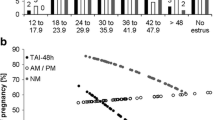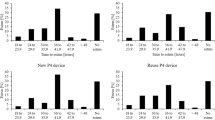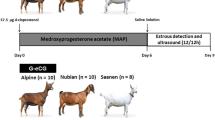Abstract
This study aimed to evaluate the reproductive performance of ewes submitted to timed AI protocol with 7 (D7) or 9 (D9) days of progesterone. A total of 220 crossbred ewes (Doper × Santa Ines) were distributed in the treatments according to body weight (52.67 ± 11.76 kg), body condition score (2.5 ± 0.8; scale of 1–5), and the female category (multiparous, nulliparous and primiparous). Ewes received an intravaginal device of 0.3 g of progesterone (CIDR® Easy breed) on day 0, keeping in ewes for 7 or 9 days, which were the experimental treatments. At the time of P4 withdrawal, ewes received 300 IU of eCG (Novormon®) and 6.70 mg of dinoprost tromethamine (Lutalyse®). Insemination by laparoscopy was performed between 46 and 59 h after device removal, lasting from 1 to 5 min/ewe, which did not differ between protocols. The estrus detection rate was higher in the 9-day protocol compared to the 7-day protocol (82% and 65%, respectively, P = 0.0096). However, the 7-day protocol tended to increase pregnancy rate on the TAI compared to the 9-day protocol (45% and 33%, respectively, P = 0.09). The plasma concentration of progesterone at device removal was higher in the 7-day protocol than in the 9-day protocol (2.35 and 1.22 ng/mL, respectively, P = 0.04). We conclude that reducing the length of the estrus synchronization protocol to 7 days is recommended, which improved the reproductive response in ewes.




Similar content being viewed by others
Data availability
The datasets generated during and/or analyzed during the current study are available from the corresponding author on reasonable request.
References
Ali, A., Hayder, M., and Saifelnaser, E.O.H., 2009. Ultrasonographic and endocrine evaluation of three regimes for oestrus and ovulation synchronization for sheep in the subtropics. Reproduction in Domestic Animals, 44, 873-878.
Balaro, M.F.A., Fonseca, J.F., Oba, E., Cruz C.E., and Brandão, F.Z., 2014. Is the Santa Inês sheep a typical non-seasonal breeder in the Brazilian Southeast?, Tropical animal health and production, 46, 1533-1537.
Bartlewski, P.M., Sohal, J., Paravinja, V., Baby, T., Oliveira, M.E.F., Murawski, M., and Keisler, D.H., 2017. Is progesterone the key regulatory factor behind ovulation rate in sheep?, Domestic Animal Endocrinology, 58, 30-38.
Bergfeld, E.G.M., Kojima, F.N., Cupp, A.S., Wehrman, M.E., Peters, K.E., Mariscal, V., Sanchez, T., Kittok R.J, Garcia-Winder, M., Kinder, J.E., 1995. Frequency of luteinizing hormone pulses and circulating 17 β-oestradiol concentration in cows is related to concentration of progesterone in circulation when the progesterone comes from either an endogenous or exogenous source. Animal Reproduction Science, 37, 257-265.
Biehl, M.V., Ferraz Junior, M.V.C., Ferreira, E.M., Polizel, D.M., Miszura, A.A., Barroso, J.P., Oliveira, G.B., Bertoloni A.L., and Pires, A. V., 2017. Effect of reproductive methods and GnRH administration on long-term protocol in Santa Ines ewes, Tropical animal health and production, 49, 1303-1308.
Biehl, M.V., Ferraz Junior, M.V.C., Barroso, J.P.R., Susin, I., Ferreira, E.M., Polizel, D.M., and Pires, A.V., 2019. The reused progesterone device has the same effect on short or long estrus synchronization protocols in tropical sheep. Tropical Animal Health and Production, 51, 1545-1549.
Carvalho, P.D., Souza, A.H., Amundson, M.C., Hackbart, K.S., Fuenzalida, M.J., Herlihy, M.M., Ayres, H., Dresch, A.R., Vieira, L.M., Guenther, J.N., Grummer, R.R., Fricke, P.M., Shaver, R.D., and Wiltbank, M.C., 2014. Relationships between fertility and postpartum changes in body condition and body weight in lactating dairy cows. Journal of Dairy Science, 3666-3683.
Diskin, M.G., Austin, E.J., and Roche, J.F., 2002. Exogenous hormonal manipulation of ovarian activity in cattle. Domestic Animal Endocrinology, 23, 211-228.
Emsen, E., Gimenez-Diaz, C., Kutluca, M., and Koycegiz, F., 2011. Reproductive response of ewes synchronized with different lengths of MGA treatments in intrauterine insemination program. Animal Reproduction Science, 126, 57-60.
Fornazari, R., Mateus, Ó., Correia, T., Quintas, H., Maurício, R., Conradi, A., Francisco, L., Álvaro, A., and Valentim, R., 2018. Estrus synchronization and artificial insemination with fresh and chilled semen in Assaf ewes. Agricultural Sciences, 9, 8-22.
Hill, J.R., Thompson, J.A., and Perkins, N.R. 1998. Factors affecting pregnancy rates following laparoscopic insemination of Merino ewes under commercial conditions: a survey. Theriogenology, 49, 697-709.
Jackson, C.G., Neville, T.L., Mercadante, V.R.G., Waters, K.M., Lamb, G.C., Dahlen, C.R., and Reddena, R.R., 2014. Efficacy of various five-day estrous synchronization protocols in sheep. Small Ruminant Research, 120, 100-107.
Martins, T., Peres, R.F., Rodrigues, A.D., Pohler, K.G., Pereira, M.H., Day, M.L., and Vasconcelos, J.L.M., 2014. Effect of progesterone concentrations, follicle diameter, timing of artificial insemination, and ovulatory stimulus on pregnancy rate to synchronized artificial insemination in postpubertal Nellore heifers. Theriogenology, 81, 446 - 453.
Ribeiro, E.L.A., and González-García, E., 2016. Indigenous sheep breeds in Brazil: potential role for contributing to the sustainability of production systems, Tropical animal health and production, 48, 1305-1313.
Santos, M.H., Ferraz-Junior, M.V.C., Polizel, D.M., Barroso, J.P.R., Miszura, A.A., Martins, A.S., Bertoloni, A.V., Oliveira, G.B., and Pires, A.V., 2018. Decreasing from 9 to 7 days the permanence of progesterone inserts make possible their use up to 5 folds in suckled Nellore cows, Theriogenology, 111, 56-61.
Swelum, A., Mouamen, A., and Alowaimer, A., 2016. Effect of 6 times reusing of controlled internal drug release (CIDR) for short term (6 days) on progesterone level and reproductive performance of awassi ewes. Reproduction, Fertility and Development, 28, 136-136.
Titi, H.H.; Kridli, R.T., and Alnimer, M.A., 2010. Estrus synchronization in sheep and goats using combinations of GnRH, progestagen and prostaglandin F2α. Reproduction in domestic animals, 45, 594-599, 2010.
Viñoles, C., Forsberg, M., Banchero, G., and Rubianes, E., 2001. Effect of long-term and short-term progestogen treatment on follicular development and pregnancy rate in cyclic ewes, Theriogenology, 55, 993–1004.
Funding
The Fundação de Amparo à Pesquisa do Estado do Amazonas (FAPEAM) and the Coordenação de Aperfeiçoamento de Pessoal de Nível Superior (CAPES) financially supported this project.
Author information
Authors and Affiliations
Contributions
A. P. Sinimbu: data curation, investigation, writing—original draft. E.M. Ferreira: conceptualization, resources. R. Denadai: investigation, funding acquisition. J. P. R. Barroso: investigation. J. S. Biava: investigation, writing—original draft. A. V. Pires: methodology, conceptualization, funding acquisition, supervision. M. V. C. Ferraz: conceptualization, methodology, formal analysis, funding acquisition, writing — review and editing. All the authors read and approved the manuscript.
Corresponding author
Ethics declarations
Statement of animal rights
The Animal Care and Use Committee from the University of São Paulo approved all the procedures with animals.
Conflict of interest
The authors declare no competing interests.
Additional information
Publisher's note
Springer Nature remains neutral with regard to jurisdictional claims in published maps and institutional affiliations.
Rights and permissions
Springer Nature or its licensor holds exclusive rights to this article under a publishing agreement with the author(s) or other rightsholder(s); author self-archiving of the accepted manuscript version of this article is solely governed by the terms of such publishing agreement and applicable law.
About this article
Cite this article
Sinimbu, A.P., Ferreira, E.M., Denadai, R. et al. The effect of progesterone length in timed AI in ewes. Trop Anim Health Prod 54, 258 (2022). https://doi.org/10.1007/s11250-022-03265-w
Received:
Accepted:
Published:
DOI: https://doi.org/10.1007/s11250-022-03265-w




